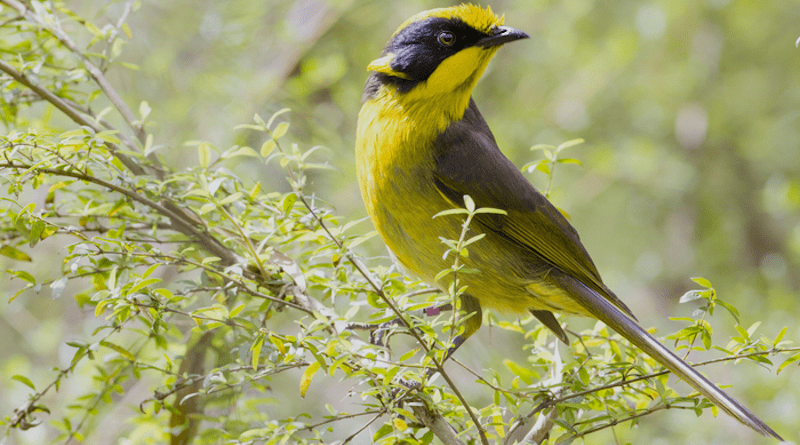New Genetic Tools Improve Potential Rescue Of Victoria’s Endangered State Bird
A team led by scientists from Monash University have completed a major milestone towards achieving the rescue of the critically endangered helmeted honeyeater, an emblem of the Australian State of Victoria. The scientists have deciphered the bird’s genome and created additional genetic information that is of such high quality it opens an additional way to potentially increase the genetic health of these birds. These new tools will allow researchers to be able to monitor the health and impact of breeding the helmeted honeyeater with another subspecies. The helmeted honeyeater also joins a very small set of birds that have both a chromosome-length genome and a genetic map. This research has been published in the open science journal GigaScience.
The helmeted honeyeater population has severely declined over the 200 years since non-indigenous people came to Australia. By the 1980s, only around 50 birds remained, all of which were at a single location in Yellingbo Nature Conservation Reserve. The use of standard conservation efforts, which include habitat restoration and a captive breeding program, have increased the population to roughly 250 individuals. However, these activities are unlikely to be sufficient to secure a long-term future for the helmeted honeyeater.
A major problem is that the small remaining population comprises mainly closely related birds with low levels of genetic variation. Accordingly, inbreeding is common, producing offspring that tend to die young and not reproduce well. A small population size also often leads to the accumulation of detrimental mutations. Thus, even if environmental conditions can be improved, these genetic problems will still make the population vulnerable to extinction through ineffective breeding and low survival, particularly if impacted by disease outbreaks and other challenges.
To increase the genetic health of the helmeted honeyeater, a team of scientists, environmental agencies, and community groups are working together to create a “genetic rescue” program by introducing genes from a subspecies outside the small gene pool of the endangered population.
Dr Alexandra Pavlova, a member of the research team at Monash University, explains: “Because the helmeted honeyeater is the last of its kind, genetic augmentation must come from a different subspecies. However, this kind of genetic mixing is not common: conservation managers generally avoid crossing subspecies for fear of losing local adaptation and distinctiveness.”
These issues can now potentially be avoided given the availability of the first chromosome-length genome sequence for the helmeted honeyeater — that is, the quality of the data is so high that the assembled sequences of the genetic “letters” cover entire chromosomes rather than the more commonly available genome sequences that are less complete and continuous.
In addition, the researchers also produced a high-density genetic map, which includes more than 50,000 marker positions. A genetic map with this many markers allows the scientists to follow exactly which part of every chromosome in an individual was inherited from each parent. The new genome sequence and genetic map will be used to guide the process of “mixing in” DNA from outside the current helmeted honeyeater gene reservoir. Together, these tools can serve as a means to inform the breeding decisions being made during the genetic rescue effort and allow this to be done with great precision.
Lead author Diana Robledo-Ruiz explains:
“The genome sequence and the genetic map will be used to get the right balance between rescuing the helmeted honeyeater from extinction through inbreeding, while retaining unique features that make it a helmeted honeyeater.”
Having such exceptional genomic resources now available begins a new chapter for rescuing the helmeted honeyeater. However, without the passion, commitment, and work of hundreds of people and many organizations, the helmeted honeyeater would already be extinct.
Prof Paul Sunnucks, a coauthor of the study, provides some specifics:
“This support includes federal and state government agencies, including the Department of Environment, Land, Water and Planning (DELWP), and Zoos Victoria. Some individuals such as Bruce Quin of DELWP have devoted 30 years or more to conservation efforts of the species, and a highly effective community group, The Friends of the Helmeted Honeyeater, has provided a range of assistance for the conservation program for more than three decades. It is an inspiring case of people caring and making a real difference to biodiversity outcomes”

